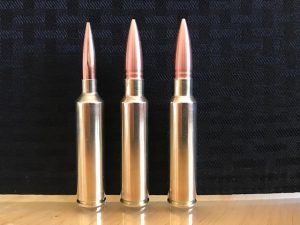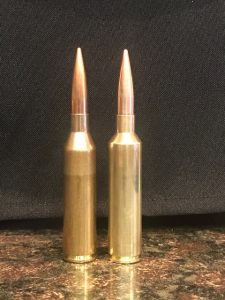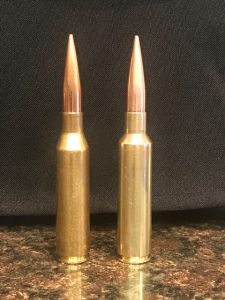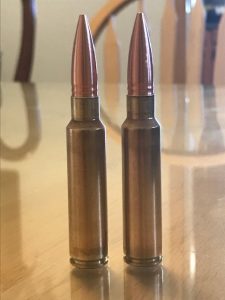The RBH Cartridge Family
RBH Cartridge Lineup
January 7, 2019OK, finally have a chance to sit down and update everyone on the RBH Cartridge family. Here is a quick recap from the January article to catch everyone up:
“This project actually started back in 2008 when a customer contacted me wanting to build a 7/338 Norma Improved. He had a reamer print design in mind, so we tweaked it a little and put the proper throating on it and chambered up his rifle. Performance was decent but we knew that brass seemed to be the limiting factor, or so we thought. Fast forward 11 years and several barrels worth of data between us, not to mention becoming very close friends and hunting partners, we have learned a lot. Now, we aren’t the only one’s wildcatting the 300/338 Norma case, but we do have a fair amount of experience and data over the last 11 years. With the development of better brass over the last couple years I decided it was time for a new lineup of cartridges.
On a recent bear hunting trip with my hunting partner Robert, we started brainstorming ideas on what would make the ideal hunting cartridge setup. So many people are focusing on the ELR market lately with their wildcats, but our focus was hunting applications. This isn’t to say that these cartridges won’t work for ELR, because they will very well, but they were designed for hunting and to optimize todays heavier for caliber bullets, yet be able to be setup in a repeater platform. Taking what I have learned over the last 11 years of shoulder angles, body taper, neck length and overall case design, I set out to design the RBH series of cartridges. The goal was to duplicate full size RUM cartridge performance in a shorter OAL package that would stay a repeater even with the heaviest of bullets. It’s pretty common knowledge that we are 7mm fanatics, so it was only natural that the 7 RBH would be the first out of the gate. Taking what I learned with the original version back in 2008 I set out on redesigning it to make it better and up the performance. I used the original platform for testing which is built on a Remington 700 with a PTG bolt. This would give me pressure indications long before the Rogue action, so it made sense to use if for “proofing”. Lapua and Peterson brass were fire formed and the testing began. Before anyone starts to ask, I was not accuracy testing, but mainly looking for velocity at this point. Velocities were impressive for the initial workup with 180’s running 3350 and 195’s running 3200. These were not max loads, but I was happy with the results. I continued to run the 180 load to finish barrel break in. 7 full power firings on the brass and primer pockets were still virgin tight and no web growth. These velocities were out of 26” barrels and using conventional powders. Case capacity ended up with 109.8gr of H20 capacity. Happy with the results, we will now look for the velocity max, but the results we are seeing at this point make this a solid hunting rifle.”
Now for the updates…..there are currently five 7 RBH’s that have been testing since January. Three of them are Apex Hunters, and two are ELR Competition rifles with 28” barrels that will be used next month at the NF ELR Match. All of the rifles have performed the same and are showing the same forgiving load tolerances. At 200 rounds on 3 of the rifles we have zero throat erosion at this time. I suspect to start seeing some movement now, but that is the price of performance. Final case capacity with Lapua 300 Norma brass is 110.1gr H20. The best part is, a loaded round even with a 195 Berger is 3.65” OAL and still allows more of the case capacity to be used than a 7 RUM! The following are the speeds we have seen in the 26” barrels:
N570/195 Berger: 3150-3274
N570/184 Berger F Hybrid: 3300-3485
Retumbo/184 Berger F Hybrid: 3245-3353
Retumbo/180 Hunting VLD: 3244-3337
The 28” barrel runs basically 45fps faster. The load we have been running the most is using Retumbo and the 184/180Hybrid/180 ELD-M. In my personal rifle it runs 3267 with an es of 0-1 depending on the day. In the 28” barreled rifles this load is running 3312 with an es of 8. Chamber pressure is around 60K with this load and is very mild and forgiving. All of the rifles have shown the save loading forgiveness and have large nodes. It wasn’t uncommon to have 1.5gr windows where the velocity didn’t change much.
Something that we have found in the light rifles especially is that at the higher speeds they are more difficult to shoot. Every little shooter form error is shown on the target. Speeds around the 3250 mark seem to be much more forgiving to shoot. This may be a difficult pill for some to swallow since the cartridge will run at much higher speeds, but the shooter input needs to be extremely consistent at the higher speeds. With that being said, a 180 class bullet at 3270 or a 195 around the 3200 mark is still impressive and effective.

7mm RBH along with the 375 RBH
Next up is the 300 RBH. Although the data is a little more limited at this time, it is still impressive and outperforms the 300 RUM by a decent margin. Plus, did I mention it’s a repeater with 230 Berger’s! The two that are out there both are running 230 OTM’s in them with N570. They will also be trying some other powders and I will update with more data later. So far N570 runs 3100-3226 from a new 26” barrel. This will speed up 40-50fps most likely when the barrels settle in. Even at the high charge on my ladder test, there was still no case head expansion or stiff bolt. Again, the 300 had some pretty wide nodes as well. During the ladder, the first 3 charges that spread across 1 grain went into a .310” diameter hole. I ran the higher load a couple more times and the primers were still tight and no case expansion with a velocity of 3226. My guess is H1000 will probably be down in the 3100 range, but RL26 may work in it as well. Case H2O capacity is 110.2 with this lot of brass. I have not tested 215’s yet, but will try on the next one.

300 Norma compared to the 300 RBH
The 338 RBH has a slightly different case design than the 7 and 300. I designed it along with the 375 as more “functional”. They both have slightly more body taper and a different shoulder angle so that feeding and extraction would never be an issue when something with sharp teeth was charging at you. My personal rifle has a 24” barrel on it and was what I did most of the load workups with. I still have a couple more bullets that I want to try and powder, but it works really well with what it has been tested with so far. Case capacity for the 338 RBH is 110.6gr H2O. It is also a repeater with a 300gr Berger and even the long 285gr Hammer Hunter.
24” Barrel Velocities with 300 Berger Elite Hunters and Peterson brass:
H1000: 2773-2821 fps
RL26: 2800-2918 fps
Again this rifle isn’t settled in yet for velocity and will speed up a little more. Again, very easy to load for and large nodes. The 26” barreled rifle that left the shop this week ran 2874fps/es of 1 with H1000 and was under .25moa. This is a top end load for H1000, but I have a feeling RL26 will do it easily with a little less pressure. Retumbo and N570 are on the list of things to test with it also. These numbers are basically what we have been running with 30” 338 Edges using H1000. Very pleased with the results on this one so far. Makes a portable 338 hammer that is a repeater with room to spare.

338 Norma compared to the 338 RBH
Lastly is the 375 RBH. This rifle is setup as one of the Alaskan Hunters with a 22” barrel. Robert had me build him one in 375 RUM last year for when he is guiding in Alaska. This was going to give us a good comparison since the two rifles are setup identical. We were hoping to match the RUM velocities but also be able to use the 329gr bullets which couldn’t happen due to the length of the RUM case. The 375 RUM runs the 281 Hammer Hunter’s at 2945 in a 22” barrel. The load Robert settled on with the 375 RBH runs the 281 Hammer Hunter’s at 2880 in the 22” barrel. He ran them up to 3084, but the best accuracy was at the 2880 load and hovers around ½” at 200 yds. 329 Hammer Hunters were in the 2700-2750 range, with 2728 being the most accurate load. Reloader 16 is the powder of choice for this guy. For now, until Lapua finally gets 338 Norma brass to us in the states, we are using 423 Dakota brass. A guy could also use Peterson 338 Norma brass as well since it is just as strong as Lapua. Case capacity with the Lapua brass is 111.8gr H2O.

375 RBH with the 281 Hammer Hunter ready for action
Still working on getting a dedicated page on the website but will soon for all the data. As more people get them, I will add their data to the page as well. For now I am only hydro forming the 7 RBH brass since it takes the most work. I may invest in the 300 RBH hydro die as well, but it’s pretty easy to just fire form it and is accurate with standard 300 Norma loads. Same goes for the 338 RBH. Head stamped brass will depend on demand. Brass manufacturers are extremely busy and seem to “price” themselves out of the business for 10-20K brass orders.

